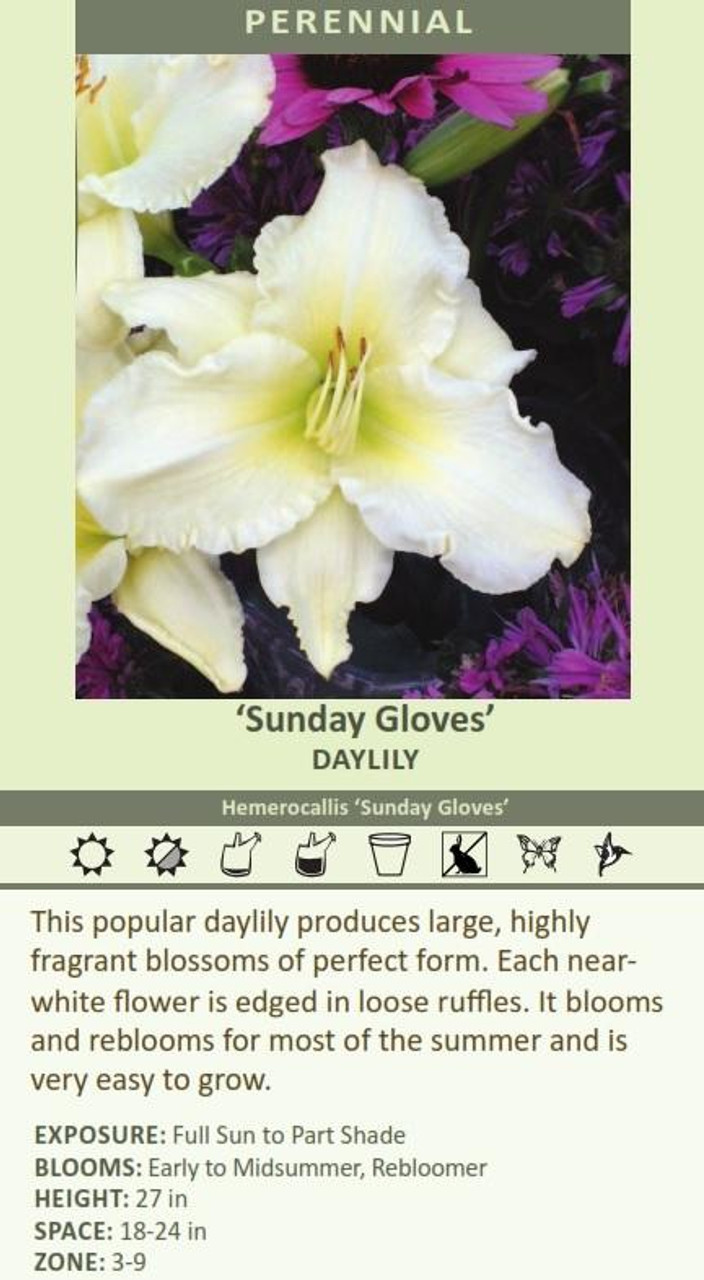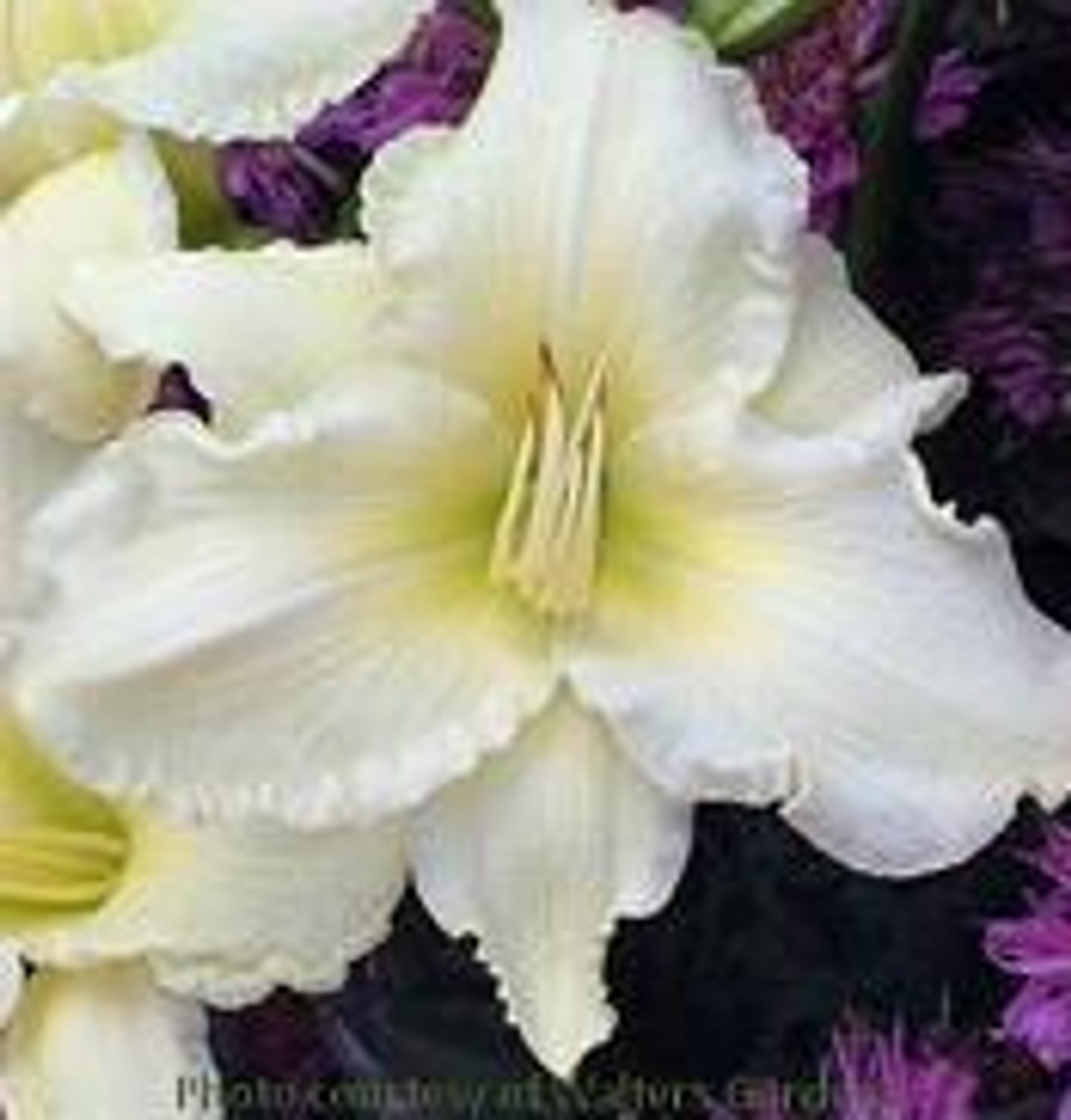Product Description
Hemerocallis 'Sunday Gloves' (25) Bare Root Plants
Common Name: Daylily
5¼", near-white blossoms are highly fragrant with loosely ruffled tepals, a pale yellow eye, and tiny celery green throat
Superior foliage and flower form
Very easy to grow
Daylilies can survive many harsh conditions that other plants cannot including: polluted city environments, slopes, poor and dry soils, near pavement that is salted in winter, and under Black Walnut trees (not affected by juglone).
- Early Midseason Bloomer, blooming in early July.
- Rebloomer, producing a second set of flowers.
- Extended Bloom with flowers staying open at least 16 hours.
- Fragrant flowers.
- Dormant foliage.
- Diploid with 22 chromosomes.
- Parents: [(JOMICO x WHITE FORMAL) X (ICE CARNICAL x DRIVEN SNOW)]
Height: 27.0 Inches
Spread: 18.0-24.0 Inches
Hardiness Zones: 3,4,5,6,7,8,9
Flower Color: White Shades
Foliage Color: Green shades
Full Sun (> 6 hrs. Direct Sun) - Part Shade (4-6 hrs. Direct Sun)
Low to Average Water Needs
Poor to Fertile Soil Quality
Bloomtime: Midsummer, Rebloomer
Attracts Butterflies and Hummingbirds
Bee Friendly
Rabbit Resistant
Growth Rate: Medium
Garden Style:
Border Plant, Container, Easy To Grow, Fragrant Flowers, Mass Planting, Salt Tolerant
Hemerocallis 'Sunday Gloves' is a daylily cultivar prized for its beautiful, fragrant flowers and vigorous growth habit. This diploid daylily has dormant foliage, meaning it dies back to the ground in winter and re-emerges in spring. 'Sunday Gloves' is an early to midseason bloomer, typically blooming in early July, and it is also a rebloomer, meaning it will produce a second set of flowers later in the season. The flowers are large, measuring 5¼ inches in diameter, and are a lovely near-white color with loosely ruffled tepals, a pale yellow eye, and a tiny celery green throat. The flowers are also highly fragrant, with a sweet, delicate scent that is especially noticeable in the evening. This cultivar boasts an impressive lineage, originating from the cross of (Jomico x White Formal) x (Ice Carnival x Driven Snow).
While many daylilies offer beauty and ease of care, 'Sunday Gloves' distinguishes itself through a unique combination of features. Its extended bloom time, reblooming capability, and delightful fragrance make it a standout choice for any garden. The flowers remain open for at least 16 hours each day, providing long-lasting enjoyment. Moreover, its reblooming nature ensures a continued display of captivating blossoms throughout the season.
Characteristics
- Early Midseason Bloomer: Flowers bloom in early July, providing a vibrant display during the peak of summer.
- Rebloomer: Produces a second set of flowers later in the season, extending the flowering period and adding continuous interest to the garden.
- Extended Bloom: Flowers stay open at least 16 hours, allowing for prolonged enjoyment of their beauty throughout the day and evening.
- Fragrant Flowers: The flowers have a sweet, delicate scent that is especially noticeable in the evening, making them a delightful addition to moon gardens or evening seating areas.
- Dormant Foliage: Foliage dies back to the ground in winter, offering a tidy appearance during the dormant season and facilitating easy maintenance.
- Diploid: Has 22 chromosomes, a characteristic that can be relevant for breeding and hybridizing purposes.
- Rust Resistance: This cultivar exhibits resistance to rust, a common fungal disease that can affect daylilies. This resistance contributes to its overall hardiness and reduces the need for chemical treatments.
Growth Habit and Size Hemerocallis 'Sunday Gloves' is a vigorous grower and can reach a height of 27 inches with a spread of 18 to 24 inches. It has a clumping habit and forms a mound of attractive foliage that is topped with elegant flowers. The foliage is a deep green color and provides a nice contrast to the near-white flowers.
Hardiness Zones Hemerocallis 'Sunday Gloves' thrives in USDA Hardiness Zones 3 through 9. This wide range encompasses diverse climates, from the cold winters of the north to the hot summers of the south. Gardeners in zones 3-8 can confidently cultivate this daylily, knowing it can withstand sustained winter cold periods necessary for its growth cycle.
Care Requirements Hemerocallis 'Sunday Gloves' is a relatively easy-to-care-for plant. It prefers full sun to light shade and fertile, moist, well-drained soil, but it will tolerate both drier and wetter soils. It is also tolerant of coastal conditions and clay soil.
Here are some more specific care requirements for Hemerocallis 'Sunday Gloves':
- Watering: Water regularly during the first growing season to help the roots establish. Once established, 'Sunday Gloves' is fairly drought-tolerant. Water deeply during prolonged dry periods.
- Fertilizing: Fertilizing is not necessary during the first few weeks of production. Actively growing daylilies are moderate feeders.
- Deadheading: Deadhead spent flowers to encourage continuous blooming and prevent self-seeding.
- Pruning: Cut back stems in late fall or early spring to maintain a tidy appearance.
- Dividing: Divide clumps every 3-4 years in spring or fall to maintain plant vigor and prevent overcrowding.
Hemerocallis 'Sunday Gloves' is a beautiful and easy-to-care-for daylily that is perfect for any garden. Its fragrant flowers, vigorous growth habit, and reblooming nature make it a standout plant in the landscape. With its wide hardiness range and adaptability to various soil conditions, 'Sunday Gloves' is a versatile plant that can be grown in a variety of climates. The extended bloom time of its elegant, near-white flowers makes it a delightful addition to borders, containers, or moon gardens. Whether you are a beginner gardener or an experienced horticulturalist, Hemerocallis 'Sunday Gloves' is a great choice for adding beauty and fragrance to your garden.
Other Details
The most important part of the plant is its root system. Healthy roots are the foundation of a healthy, vibrant plant. The type of plug container used is based on the specific needs of the plants. Perennials offered as bare root traditionally perform better when planted as bare root.Planted in a specialized mix, potted plants have well established root systems. Top growth stage will vary depending on the current life cycle and time of year when shipped. In Winter and early Spring dormant plants may be shipped. Dormant plants may be planted right away, even before the last frost date.
Most bare root varieties are field grown for at least one season, though Hemerocallis and Hosta are grown for two seasons. The bulk of the soil is removed during the harvesting process and the tops of most varieties are trimmed back to the crown. They are graded, packed in shredded aspen or sphagnum moss and stored in freezers until ready to be shipped.
See our Container Sizes and Bare Root Perennials pages for more information.
Plant information and care is provided in the Overview section, Plant Genus Page and general information is provided in the Planting Care & Guides. Additional questions can be asked on each Plant page.
Plant Spacing: Using the maximum mature spread or width of a plant to guide spacing, ensures space to grow to full size. To fill an area sooner, plant them closer together. Just remember, future thinning or transplanting may be needed.
Water: Keep a close eye on newly planted perennials, especially throughout the first growing year. Most early plant loss is due to too much or too little water!












